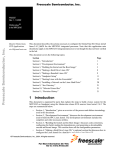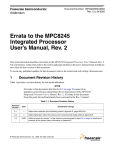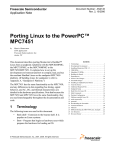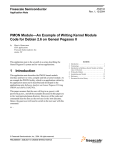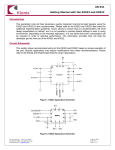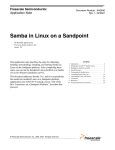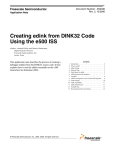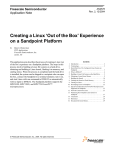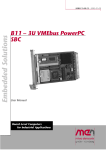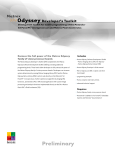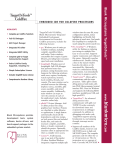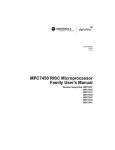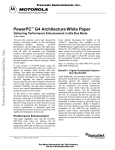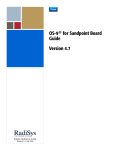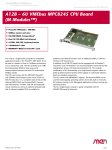Download AN2273:Building an NFS DHCP/BOOTP Server for Use with
Transcript
Freescale Semiconductor, Inc.
Rev. 1.1, 6/2003
Freescale Semiconductor, Inc...
Building an NFS
DHCP/BOOTP Server
for Use With Sandpoint
and MVP Linux
Maurie Ommerman
CPD Applications
risc10@email.
mot.com
This document describes the steps necessary to configure a Linux DHCP/BOOTP server for
use with the MontaVista Hard Hat Linux™ CDK, V2.0, running on either a Sandpoint or MVP
evaluation board client. PowerPC™ microprocessors are supported on the Sandpoint and
MVP evaluation boards.
This document covers the following topics:
Part
Page
Part I, “Introduction”
Part II, “General Methodology”
Part III, “Server Machine”
Part IV, “Installing the MontaVista CDK V2.0”
Part V, “Linux Boot Methods”
Part VI, “Dynamic Host Configuration Protocol (DHCP)”
Part VII, “Trivial File Transfer Protocol (TFTP)”
Part VIII, “Set up Network File System”
Part IX, “Set Up resolv.conf File”
Part XI, “Host Ethernet Diagnostic Commands”
Part XII, “Starting Linux with the Executable”
Part XIII, “Revision History”
CAUTION
Do not copy IP addresses verbatim from this document; use
a correct IP address for your network.
Do not have more than one DHCP server active per network.
Refer to Part VI, “Dynamic Host Configuration Protocol
(DHCP).”
© Freescale Semiconductor, Inc., 2004. All rights reserved.
For More Information On This Product,
Go to: www.freescale.com
2
5
7
8
9
10
13
16
17
18
20
29
Freescale Semiconductor, Inc.
NOTE
The MontaVista Hard Hat Journeyman Edition does not fully support
Yellow Dog Linux™ as a host. Although it can be set up as a
DHCP/BOOTP server, and perform an NFS boot, the resulting root file
system will be read-only. Because you can not change the files, useful
work cannot be accomplished on this platform and host combination.
However, the full MontaVista release does support Yellow Dog Linux as a
host. I have not tested this full version.
Freescale Semiconductor, Inc...
On the other hand, Red Hat™ V7.0, which is supported, and Red Hat™
V7.2, which is not supported by MontaVista, work correctly. The NFS
boot mounts the root file system read/write, permitting the performance of
useful work on both of these platform and host combinations.
Part I Introduction
This document is organized by parts that explain the steps required [summarized in Section 2.2, “Required
Server Steps”] to configure a Linux system for serving NFS remote boot from a DHCP/BOOTP server.
•
•
•
•
•
•
Part I, “Introduction,” gives an overview of this document and defines terminology used.
Part II, “General Methodology,” provides an overview of client and server interaction and
summarizes the steps in the configuration process.
Part III, “Server Machine,” discusses the server development environment and the required Red
Hat package manager (RPM) compilers and utilities.
Part IV, “Installing the MontaVista CDK V2.0,” provides general information about installing the
CDK V2.0. and indicates where instructions can be found to produce the necessary kernel for the
PowerPC architecture. This section also indicates directory locations.
Part V, “Linux Boot Methods,” outlines common methods of booting Linux, depending on the
hardware used.
Part VI, “Dynamic Host Configuration Protocol (DHCP),” repeats a critical notice regarding IP
addresses and servers. It also outlines how to set up and configure DHCP, including:
— The necessary code for the DHCP daemon configuration file
— A line-by-line explanation of that code
— Instructions for restarting the DHCP daemon
•
•
•
•
•
Part VII, “Trivial File Transfer Protocol (TFTP),” addresses the trivial file transfer protocol (TFTP)
requirements based on the Linux software release used. Also included is the code for the
recommended TFTP file, with a line-by-line explanation of the code, instructions for creating a
symbolic link, and restarting the TFTP.
Part VIII, “Set up Network File System,” discusses how to set up the network file system (NFS)
export files, provides recommendations on code to be added to the export files, and outlines
procedures for controlling the NFS daemon.
Part IX, “Set Up resolv.conf File,” provides directions to build the resolv.conf file, which performs
domain name resolution. The recommended code is included with a line-by-line explanation.
Part X, “Other Problems,” addresses how to resolve a common problem, shell start failure. A link
is provided for the /opt/hardhat/devkit/ppc/82xx/target/bin directory.
Part XI, “Host Ethernet Diagnostic Commands,” gives instructions for:
— Checking the status of gateway and network setup
Building an NFS DHCP/BOOTP Server for Use With Sandpoint and MVP Linux
For More Information On This Product,
Go to: www.freescale.com
Freescale Semiconductor, Inc.
Terminology
— Viewing network traffic
— Using the message log
•
•
1.1
Part XII, “Starting Linux with the Executable,” addresses downloading the executable. It also
provides examples of both the MVP and Sandpoint splash screens, as well as a sample Sandpoint
session.
Part XIII, “Revision History,” provides the document history.
Terminology
Freescale Semiconductor, Inc...
The following terms are used in this document.
•
Bash shell—Extension to the Bourne shell, which is popular on Linux systems and is sometimes
called GNU Born Again Bourne Shell. This is the default shell for most Linux systems because
Linux uses GNU tools exclusively.
•
Boot—Program that begins at hardware reset, which prepares the hardware for loading an OS.
•
BOOTP—Short for bootstrap protocol, this is a broadcast request from a client to a BOOTP server,
which is usually a DHCP server. If the server determines that the client is valid, an IP address is
returned to the client, permitting the boot process to continue.
•
Broadcast—Sends a message to all listeners on an Ethernet or subnet.
•
Client—A program or machine that makes requests to another machine called a server.
•
CDK—Cross Development Kit is a set of development tools for Intel- or Mac-based Linux
machines to build PPC Linux objects.
•
Daemon—A Linux and Unix term that refers to a small program that runs in the background and is
owned by root. A daemon listens for activity, which it can respond to and then performs services
for that activity. Daemons pertinent to this document include inetd, xinetd, and dhcpd.
•
DINK32—Small OS debugger for the Sandpoint evaluation board.
•
DHCP—Dynamic host configuration protocol used by a server to respond to client requests for
automatic assignment of IP addresses.
•
dhcpd—This daemon performs the DHCP service, monitoring ethernet traffic to identify incoming
requests for IP address assignment and responding to these requests if they are validated.
•
FTP—File Transfer Protocol, used for tranferring files between machines on a network.
•
Hard Hat Linux—Also called hhl, a product of MontaVista Software.
•
Host—A machine that can be used to build kernels. The host may or may not be the same
architecture. For example, Freescale builds kernels on both a G4 machine and a Intel machine.
•
IDE—Integrated Device Electronics is the standard interface for many devices including hard
drives, CD-ROM drives, and others.
•
inet, inetd—inet is the Internet service performed by inetd, a daemon that monitors ethernet traffic
to identify incoming traffic destined for the IP address on which the daemon resides. This daemon
is supported by Mandrake Linux V7.0.
•
IP Address—Internet Protocol address, a quartet of digits that represent the addressing scheme and
identify the packet format. The IP address is usually represented by decimal numbers that
specifically identify a node in a network. Each entry of the quartet has a value from 0 to 256. The
representation is xxx.yyy.zzz.aaa.
•
Kernel—The central module of OS that interfaces the hardware to the software.
Building an NFS DHCP/BOOTP Server for Use With Sandpoint and MVP Linux
For More Information On This Product,
Go to: www.freescale.com
Freescale Semiconductor, Inc.
Freescale Semiconductor, Inc...
Terminology
•
Mandrake Linux—Product of MandrakeSoft, Inc. (designer and distributor of desktop Linux
sources and solutions).
•
MAC—Media Access Control is the physical address of an ethernet card. Represented by a sextet
of hex values, each member has a value from 00–ff. The first three members are assigned to a
manufacturer, the last three members are uniquely assigned by the manufacturer. The
representation is xx:yy:zz:aa:bb:cc.
•
MontaVista Software—One of several companies that modifies and distributes Linux sources for
embedded applications.
•
MVP —An evaluation board, with a Galileo network interface, that uses two MPC7450 processors
and is capable of running an SMP Linux.
•
NFS—Network File System, a protocol used to share and access files over a network regardless of
machine, operating system, or architecture.
•
OS—Operating system.
•
RAM disk—Random Access Memory that has been configured to simulate a disk drive.
•
Red Hat—Red Hat, Inc. is one of several companies that uses the freely distributed desktop Linux
sources and packages them for distribution. They developed the RPM which has become a
standard for Linux.
•
Red Hat package manager (RPM)—Program to install and to maintain groups of Linux binary,
libraries, documentation, and other Linux-style objects.
•
Required files—DHCP/BOOTP servers rely on certain files that define the actions of these servers.
•
Server—A machine that services requests from clients.
•
SMP—Symmetric multiprocessing program, a computer architecture that features a single
operating system that uses two or more processors.
•
Srecord or srec—A file that depicts a binary object file in an ASCII representation. DINK32 can
download either srec or binary files. See Appendix D in the DINK32 User’s Manual.
•
Sandpoint—Evaluation board for Freescale MPC6xx, 7xx, 74xx, 82xx processors. This board does
not include an internal ethernet card.
•
Target—Machine used with the kernel. For this application note, the target machine is either the
Sandpoint or MVP machine.
•
TFTP—Trivial File Transfer Protocol is a simple form of the FTP that features UDP and provides
no security features.
•
UDP—User DatagramProtocol, a communications protocol for the Internet network layer,
transport layer, and session layer, which makes it possibe to send a datagram message from one
computer to an application running in another computer.
•
User and root type—Root user has super user permission to install RPMs, modify, create, and
delete all files in all directories, mount and unmount file systems, start and end processes, and
generally do anything on a Linux system. Unfortunately, this makes it easy to destroy the Linux
development system and render it useless. For that reason, login as a root user only for those
activities that require root permissions, and revert to normal user for all other activities, including
building the Linux kernel. However, all the activities described in this paper require root
permission, so care should be exercised in making these recommended changes.
•
xinet, xinetd—xinet is the Internet service performed by xinetd, a daemon that monitors ethernet
traffic to identify incoming traffic destined for the IP address on which it resides. This service and
daemon is supported by Red Hat Linux V7.2 or Yellow Dog Linux V2.1.
Building an NFS DHCP/BOOTP Server for Use With Sandpoint and MVP Linux
For More Information On This Product,
Go to: www.freescale.com
Freescale Semiconductor, Inc.
Overview
•
Yellow Dog Linux™—Product of Terra Soft Solutions, Inc., designer and distributor of of desktop
Linux sources and solutions.
Part II General Methodology
The instructions in this application note are identical for Red Hat Linux V7.2, Mandrake Linux V7.0 (similar
to Red Hat V7.0), and Yellow Dog Linux V2.1, except as noted. Much of this material is based on Hard Hat
Linux 2.0 Journeyman Edition Installation and Setup Guide (supplied with the MontaVista distribution
package).
Freescale Semiconductor, Inc...
Included in this section is an overview of the boot process and the steps required to build the NFS
BOOTP/DHCP server.
2.1
Overview
This overview shows the interaction between a client and the NFS BOOTP/DHCP server, during the boot
process. The process for BOOTP request is defined in the following steps. The BOOTP request routine for
a known client is demonstrated in Figure 1.
•
A boot record is loaded on the client (Sandpoint or MVP), initializes an ethernet driver, makes a
connection, and broadcasts a BOOTP request which contains the client’s MAC address.
•
The BOOTP request is sent to a subnet and, if no BOOTP server is listening, the client times out.
•
If a BOOTP server is listening, it responds. In this case, we are using a DHCP server.
•
The DHCP server initially accepts the BOOTP request and compares the client’s MAC address to
a list of known valid clients (dhcpd.conf file).
•
If it is not a valid client, the server refuses the request.
•
If it is a valid client, the server responds with an IP address.
Boot
Record
Client
DHCP/BOOTP
Server
Bootp Request
Using MAC Address
dhcpd.conf
file
MAC Address
Found in Client
List
IP Address
Figure 1. BOOTP Request Routine For Known Client
The following steps summarize the balance of the boot process. Figure 2 represents the boot record and root
file system pointer request routine.
Building an NFS DHCP/BOOTP Server for Use With Sandpoint and MVP Linux
For More Information On This Product,
Go to: www.freescale.com
Freescale Semiconductor, Inc.
Required Server Steps
•
The client then configures itself, using the IP address that was sent from the BOOTP server.
•
The client then requests a pointer to a boot record and a root system file.
•
The server responds with this information.
•
Using the the pointer, the client may download the boot record, and continues the boot process.
•
The client connects to the root file system.
Received
Valid IP
Address
Freescale Semiconductor, Inc...
Client
DHCP/BOOTP
Server
IP Address
Found in
Client List
(/etc/exports)
Request for
Pointers to Boot Record
and Root File System
using IP Address
Client Can Now
Access the Root
File System
dhcpd.conf
/etc/exports
Root File
System
Root File System Pointer
Figure 2. Boot Record and Root File System Pointer Request Routine
2.2
Required Server Steps
The following steps are required to build the NFS BOOTP/DHCP server. These steps are detailed in the
sections that follow.
1. Install MontaVista CDK V2.0 with a target root system.
2. Build a kernel that uses an NFS boot on a host.
See Application Note AN2222/D, Porting Linux to the MPC8245.
3. Read very carefully the cautionary note found in Part VI, “Dynamic Host Configuration Protocol
(DHCP).”
4. Install, set up, and start a DHCP server.
5. Install, set up, and start a TFTP protocol.
6. Create a symbolic link to the boot kernel.
7. Set up NFS, includes exports file set up.
8. Set up a hostname.
Building an NFS DHCP/BOOTP Server for Use With Sandpoint and MVP Linux
For More Information On This Product,
Go to: www.freescale.com
Freescale Semiconductor, Inc.
Server Environment
Part III Server Machine
This section describes the server environment, identifying the software releases used, and details the Red
Hat Package Manager packages (RPMs) that are required to build the server.
3.1
Server Environment
Freescale Semiconductor, Inc...
Two server platforms are available, the G4 Mac and the PC. The instructions shown here are identical
regardless of which platform is used. The process defined in this document was executed using three
different servers, RedHat Linux 7.2 on a PC (Pentium 166MHz) and Mandrake LinuxV7.0 on a PC
(Pentium 166MHz); it was also executed on the G4 PPC using Yellow Dog Linux V2.1.
It is critical that, per the platform selected, the NFS connected boot image must include the object code for
that specific target system. In this case, both target systems, that is, the Pentium 166 MHz PC, which does
not support PowerPC architecture, and G4 PPC, which does implement PowerPC architecture. MontaVista
CDK, V2.0 supplies this NFS connected boot image. Thus, the target system has PowerPC executables and
can reside on either a non-PowerPC system or on a system using the PowerPC architecture.
To create a server machine, do one of the following:
•
Install Linux on a PC, using either the RedHat or Mandrake distribution.
•
Install LinuxPPC on a G4-running Mac OS, using the Yellow Dog distribution.
3.2
Required Red Hat Package Manager Packages
(RPMs)
Certain RPMs must be installed depending on the version of Linux being used. The following sections
indicate the RPMs and dependencies.
3.2.1
MontaVista CDK, V2.0
In order to build an srecord, use of zsrec instruction is required, that is only available from MontaVista and
is included on the MontaVista release in the /common/ directory of the CDROM. See Part IV, “Installing the
MontaVista CDK V2.0” for additional information. The instructions to build a kernel and the related srecord
are found in AN2222/D, Porting Linux to the MPC8245, available on the Freescale web site,
www.freescale.com.
•
3.2.2
rpm-ihv hhl-zsrec-1.05.i386.rpm
Host System
Load the appropriate RPM, depending on the version of Linux being used. In this case, the version used was:
•
dhcp-2.0pl5-8.i386.rpm
NOTE
This is the current version for Red Hat V7.2. You must have some version
of DHCP installed.
Building an NFS DHCP/BOOTP Server for Use With Sandpoint and MVP Linux
For More Information On This Product,
Go to: www.freescale.com
Freescale Semiconductor, Inc.
General Information
•
xinetd-2.3.3-1.i386.rpm
NOTE
This is the current version for Red Hat V7.2. You must have some version
of xinetd installed for Red Hat V7.2 and Yellow Dog V2.1.
•
netkit_base-0.11-15mdk
NOTE
This is the current version of inetd for Mandrake V7.0.
Freescale Semiconductor, Inc...
Part IV Installing the MontaVista CDK V2.0
Covered in this section is a summary of general information to assist in installing MontaVista Hard Hat
Linux CDK V2.0, an overview of the corrections and differences to be considered, and directory locations.
4.1
General Information
You must install the PPC Cross Development Kit V2.0, which includes the target boot disk image.
Obtain the MontaVista Hard Hat Linux CDK V2.0 from the MontaVista web site, www.mvista.com. Install
the PPC Linux kernel. For a host system that is based on a processor that implements the PowerPC Mac G4,
you will use the native GNU tool chain. For host systems not based on the PowerPC architecture, install the
PPC GNU cross tool chain.
In both cases, the user must produce a code kernel for the PowerPC architecture. A complete discussion on
building the kernel is given in Application Note AN2222/D, Porting Linux to the MPC8245.
Follow the instructions supplied with the MontaVista distribution for the proper install. In this case, install
the 82xx kernel and tools for a cross-hosted development, described in Chapter 2 of Hard Hat Linux 2.0
Journeyman Edition Installation and Setup Guide available from MontaVista Software.
4.2
Corrections and Differences
The MontaVista 2.0 script, /mnt/cdrom/bin/hhl-host-install (see Hard Hat Linux 2.0 Journeyman Edition
Installation and Setup Guide,” page 7) is designed for the Red Hat V7.0 and will not work on other versions
of Red Hat. This document is based on Red Hat V7.2.
An easy fix for any Linux development system is to change the release name temporarily. For Red Hat Linux
V7.2, edit the file /etc/redhat-release, changing one line only. Change Red Hat Linux release 7.2 (Enigma)
to Red Hat Linux release 7.0 (Enigma).
Be certain to change the line back after installing Hard Hat Linux.
Both the Mandrake release and the Yellow Dog release also have this /etc/redhat-release file. Hence, this
install script works with any Red Hat, Mandrake, and Yellow Dog.
NOTE
This document is written for the Red Hat Release 7.2. All differences
between this, Mandrake (Red Hat V7.0) and Yellow Dog V2.1 are
indicated in the appropriate sections.
Building an NFS DHCP/BOOTP Server for Use With Sandpoint and MVP Linux
For More Information On This Product,
Go to: www.freescale.com
Freescale Semiconductor, Inc.
Directory Locations
The complete command to install the MontaVista target directory is:
/mnt/cdrom/bin/hhl-host-install --install --lspfreescale-sandpoint-82xx
This procedure has been tested on Red Hat V7.2, Mandrake V7.0, and Yellow Dog V2.1.
NOTE
The Yellow Dog host will get some errors during this install. These errors
can be ignored. However, the root file system will be mounted as read-only
on Sandpoint.
Red Hat V7.2 and V7.0 does not get errors and the root file system is
mounted as read/write, and that is the expected result.
Freescale Semiconductor, Inc...
4.3
Directory Locations
Once installed, all the code and tools will reside starting in the directory, /opt.
•
/opt/hardhat/host
— contains some important cross tools, specifically, the zsrec application that converts elf files
into srecord files. This directory is only created on non PPC systems.
•
/opt/hardhat/devkit/ppc/82xx/bin
— contains all the cross compiler tool chain for systems not based on the PowerPC architecture.
•
/opt/hardhat/devkit/ppc/82xx/target
— contains a linux target system that can be used to build a Linux hard drive. This is the directory
that is used for the NFS remote boot.
•
/opt/hardhat/devkit/lsp
— contains all the kernel code for specific architectures. You want the freescale-sandpoint
distribution. Specifically, you will find this distribution at
/opt/hardhat/devkit/lsp/freescale-sandpoint/linux-2.4.2_hhl20.
/opt is owned by root and therefore you must have root permission to make any changes to these directories
Part V Linux Boot Methods
This section outlines common methods of booting Linux, depending on the hardware used.
5.1
Hard Drive Boot
If you are using a hard drive for your system, see Part IV in Application Note AN2222/D, Porting Linux to
the MPC8245.
5.2
RAM Disk
If you are using a RAM disk for your system, see Part V in Applicaton Note AN2222/D, Porting Linux to
the MPC8245.
Building an NFS DHCP/BOOTP Server for Use With Sandpoint and MVP Linux
For More Information On This Product,
Go to: www.freescale.com
Freescale Semiconductor, Inc.
NFS Remote Boot
5.3
NFS Remote Boot
The NFS remote boot from a server onthe network is the subject of this paper.
Part VI Dynamic Host Configuration Protocol
(DHCP)
Freescale Semiconductor, Inc...
This section outlines how to set up and configure dynamic host configuration protocol (DHCP) and includes
the necessary code for the DHCP daemon configuration file, a line-by-line explanation of that code, and
instructions for restarting the DHCP daemon.
CAUTION
Do not copy IP addresses verbatim from this document; use a correct IP
address for your network.
Do not have more than one DHCP server active per network.
Refer to Part VI, “Dynamic Host Configuration Protocol (DHCP).”
6.1
Set Up DHCP
Before configuring the DHCP, ensure that it is installed. Select a method based on the version of Linux being
used.
•
Red Hat V7.x and Yellow Dog V2.1: Ensure that the file, “/var/lib/dhcp/dhcpd.leases,” exits or
create an empty file with the touch command.
•
Red Hat V6.x: Ensure that the file, “/var/state/dhcp/dhcpd.leases,” exits or create an empty file
with the touch command.
6.2
Configuring DHCP
The following sections address configuring the DHCP.
6.2.1
General DHCP Documentation
To configure a DHCP server, first create a configuration file. Composed of two types of statements,
parameters and declarations, the configuration file stores network information for clients including:
•
Parameters determines the following:
— What network configuration options to send a client.
— If a task should be performed
— How the task is to be performed.
•
Declarations describe the network and its clients. Declarations also provide addresses for the
clients. There are two distinct declaration options:
— Global declarations apply to all network clients.
— An individual option declaration applies to a specific client system.
Building an NFS DHCP/BOOTP Server for Use With Sandpoint and MVP Linux
For More Information On This Product,
Go to: www.freescale.com
Freescale Semiconductor, Inc.
Configuring DHCP
Consider the following points when developing a configuration file:
•
Simplify formatting by using extra tabs or blank lines in the configuration file.
•
Lines beginning with a hash mark (#) are comments.
•
Key words are not case sensitive.
•
Parameters beginning with the “option” keyword are required to configure DHCP options.
•
Parameter statements not beginning with the “option” keyword either control the DHCP server
behavior or provide non-optional values.
•
Global parameters are those parameter declarations (including options) found prior to a section
surrounded by curly brackets ({}) and apply to all sections that follow.
Freescale Semiconductor, Inc...
Refer to Chapter 12 of The Official Red Hat Linux Customization Guide found on http://www.redhat.com
for more information.
NOTE
Changes to a configuration file do not take effect until the DHCP daemon
is restarted using the following command:
service dhcpd restart
6.2.2
DHCP Daemon Configuration File
Before making any changes, please read the cautionary note found in the introduction to Part VI, “Dynamic
Host Configuration Protocol (DHCP).”
Edit the /etc/dhcpd.conf file, using the following dhcpd.conf file and inserting the appropriate IP addresses:
allow bootp;
subnet 163.11.104.0 netmask 255.255.255.0 {
option routers 163.11.104.254;
group {
host realtek1 {
hardware ethernet 00:40:c7:87:50:b2;
fixed-address 163.11.104.163;
filename "vmlinuz-freescale-sandpoint";
option root-path "/opt/hardhat/devkit/ppc/82xx/target";
}
host mvp1 {
hardware ethernet fe:ff:ff:00:00:01;
fixed-address 163.11.104.164;
filename "vmlinuz-freescale-sandpoint";
option root-path "/opt/hardhat/devkit/ppc/82xx/target";
}
}
}
Building an NFS DHCP/BOOTP Server for Use With Sandpoint and MVP Linux
For More Information On This Product,
Go to: www.freescale.com
Freescale Semiconductor, Inc.
Configuring DHCP
6.2.2.1
Line by Line Explanation
The DHCP daemon configuration file is explained here.
1. allow bootp;
The NFS booting Linux client will issue a BOOTP request to the network. This server will respond
to the request by sending a valid IP address, or refusing an unknown requester.
2. subnet 163.11.104.0 netmask 255.255.255.0 {
This line denotes the subnet for the requesters, in this case, any requester on the triplet net
163.11.104. The netmask indicates to listen to all nets. Specify an appropriate subnet for your
installation.
Freescale Semiconductor, Inc...
3. option routers 163.11.104.254;
This is the address of the router for this subnet; specify a correct router for your network.
4. group {
This line indicates the beginning of this group of clients.
5. host realtek1 {
In this case there are two clients. This is the first client and its name is, realtek1, because we are
using a Realtek ethernet card on a sandpoint since there is no internal ethernet interface. It could be
any name you desire, however, it should correspond to the client’s name. Even though this is
setting up a client connection, this file calls it a host.
6. hardware ethernet 00:40:c7:87:50:b2;
This is the MAC address of the client. When the client sends a BOOTP request on this subnet, it
sends it’s MAC address. Specify the correct MAC address for your client.
7. fixed-address 163.11.104.163;
When the client with this specified MAC address issues the BOOTP request, this server will
respond with this IP address. The client will then use this IP address. Specify an appropriate IP
address here.
8. filename "vmlinuz-freescale-sandpoint";
This is the initial boot file, that the client will use. This file is in
/opt/hardhat/devkit/ppc/82xx/target/boot.
NOTE
Hard Hat Linux 2.0 Journeyman Edition Installation and Setup Guide,
page 103 lists the available boot file names.
9. option root-path "/opt/hardhat/devkit/ppc/82xx/target";
This line specifies the path for the clients NFS mount. All files normally in a mount root file
system are here on the hard drive of the server.
10. }
Close host realtek1 record. This ends the configuration for the first client.
11. host mvp1 {
This is the second client, called mvp1, which uses an mvp board with the Galileo network
interface.
12. hardware ethernet fe:ff:ff:00:00:01;
This is the second client’s MAC address.
13. fixed-address 163.11.104.164;
This is the IP that will be assigned to this client.
Building an NFS DHCP/BOOTP Server for Use With Sandpoint and MVP Linux
For More Information On This Product,
Go to: www.freescale.com
Freescale Semiconductor, Inc.
Mandrake V7.0 (Red Hat V7.0)
14. filename "vmlinuz-freescale-sandpoint;
Again, this is the initial boot file.
15. option root-path "/opt/hardhat/devkit/ppc/82xx/target";
Again, this is the path for the NFS mount.
NOTE
Note that both clients are now using the same system file path. If either
client changes anything in these directories, it will affect both clients. This
is controlled in the file /etc/exports, see 8.1, “Set Up the Exports File”.
16. }
Close host mvp1 record. This ends the configuration for the second client.
Freescale Semiconductor, Inc...
17. }
Close group.
18. }
Close subnet.
NOTE
default-lease-time and max-lease-time are not needed here,
they are assumed to be infinite, that is, the client keeps the lease until it
releases it.
This server will only serve two clients, MAC addresses 00:40:c7:87:50:b2
and fe:ff:ff:00:00:01. Any other client requester will be refused.
6.2.3
Restarting the DHCP Daemon
Assuming the DHCP daemon is running, it is automatically started up when linux boots, it is now necessary
to restart the daemon. The daemon only reads its configuration file, dhcpd.conf, when starting.
Issue one of the following commands:
/etc/rc.d/init.d/dhcpd restart
or
service dhcpd restart
As a result, the following should appear on the console.
Shutting down dhcpd: [ OK
Starting dhcpd: [ OK ]
]
Part VII Trivial File Transfer Protocol (TFTP)
This section provides the information needed to set up the TFTP, including Linux release specific
instructions, the TFTP file code, an explanation of the TFTP file code, the commands needed to create a
symbolic link to the boot file, and TFTP restart instructions.
7.1
Mandrake V7.0 (Red Hat V7.0)
Edit /etc/inetd.conf and uncomment the TFTP line, as there is no TFTP file.
Building an NFS DHCP/BOOTP Server for Use With Sandpoint and MVP Linux
For More Information On This Product,
Go to: www.freescale.com
Freescale Semiconductor, Inc.
Red Hat V7.2 and Yellow Dog V2.1
# Tftp service is provided primarily for booting. Most sites
# run this only on machines acting as "boot servers." Do not uncomment
# this unless you *need* it.
#
tftp
dgram
udp wait
root
/usr/sbin/tcpd in.tftpd
7.2
Red Hat V7.2 and Yellow Dog V2.1
There is no /etc/inetd.conf, instead the same functionality is created in the following manner.
•
Freescale Semiconductor, Inc...
7.3
Create or edit this file, /etc/xinetd.d/tftp
TFTP File
Below is the code for the TFTP file being used.
service tftp
{
socket_type
protocol
wait
user
server
server_args
disable
}
7.3.1
=
=
=
=
=
=
=
dgram
udp
yes
root
/usr/sbin/in.tftpd
-s /tftpboot
no
Line by Line Explanation
The TFTP file code is explained here.
1. service tftp
Required first line to specify the service
2. {
Indicate start of information.
3. socket_type
Using datagram service
= dgram
4. protocol
The protocol is udp
= udp
5. wait
wait for service
= yes
6. user
This service must run in root
= root
= /usr/sbin/in.tftpd
7. server
We chose to use our own local server, using the local TFTP service. The MontaVista target also
contains a TFTP service, which is suggested in Hard Hat Linux 2.0 Journeyman Edition
Installation and Setup Guide. The alternative line to use the service supplied by MontaVista is:
server
= /opt/hardhat/host/bin/in.tftpd
Building an NFS DHCP/BOOTP Server for Use With Sandpoint and MVP Linux
For More Information On This Product,
Go to: www.freescale.com
Freescale Semiconductor, Inc.
Create a Symbolic Link
8. server_args
= -s /tftpboot
Our local tftp requires the -s argument. The MontaVista target does not requres the -s argument so
its line would be:
server_args
= /tftpboot /*
9. disable
= no
Do not disable this service, that is, allow remote access.
10. }
Indicates the end of information
Freescale Semiconductor, Inc...
7.4
Create a Symbolic Link
TFTP can only download files in the TFTP boot directory. Therefore, in order for the client to download an
optional kernel, a link to this kernel must be placed in the TFTP boot directory.
Create a symbolic link in the TFTP boot directory to the boot file with the following commands:
cd /tftpboot
ln -s /opt/hardhat/devkit/ppc/82xx/target/boot/vmlinux-freescale-sandpoint
vmlinux-freescale-sandpoint
To see the link, execute this command:
ls -l vmlinux-freescale-sandpoint
As a result the link is displayed, prefixed by the letter “l,” as highlighted in this example:
lrwxrwxrwx
1 root
root
67 Feb 21
vmlinux-freescale-sandpoint
/opt/hardhat/devkit/ppc/82xx/target/boot/vmlinux-freescale-sandpoint
7.5
Restart TFTP
Per the Linux release being used, issue the following commands as needed.
7.5.1
Mandrake V7.0 (Red Hat V7.0)
Use any of the following commands to restart TFTP.
killall -HUP inetd
or
/etc/rc.d/init.d/inet stop
/etc/rc.d/init.d/inet start
NOTE
Note the stop/start version is inet, not inetd.
7.5.2
Red Hat V7.2 and Yellow Dog V2.1
Use any of the following commands to restart TFTP.
killall -HUP xinetd
Building an NFS DHCP/BOOTP Server for Use With Sandpoint and MVP Linux
For More Information On This Product,
Go to: www.freescale.com
10:48
->
Freescale Semiconductor, Inc.
Set Up the Exports File
or
/etc/init.d/xinetd stop
/etc/init.d/xinetd start
or
service xinetd restart
Part VIII Set up Network File System
Freescale Semiconductor, Inc...
This section details the steps to setting up the NFS, including setting up the exports file and controlling the
NFS daemon.
8.1
Set Up the Exports File
The server refers to the exports file to determine which requesters, via their IP address, are qualified to
access, that is, export, this root file system. Edit the /etc/exports file by adding the appropriate line described
in Section 8.1.1, “Valid Line for Red Hat V7.2” or Section 8.1.2, “Recommended Line.”
8.1.1
Valid Line for Red Hat V7.2
The following line may be used for Red Hat Linux V7.2:
/opt/hardhat/devkit/ppc/82xx/target
163.11.104.*(rw,no_root_squash,no_all_squash)
8.1.2
Recommended Line
The following form works with all three Linux releases, for Red Hat V7.2, MontaVista V7.0, and Yellow
Dog V2.1. This is the recommended version:
/opt/hardhat/devkit/ppc/82xx/target
163.11.104.0/24(rw,no_root_squash,no_all_squash)
or
/opt/hardhat/devkit/ppc/82xx/target
163.11.104.0/255.255.255.0(rw,no_root_squash,no_all_squash)
This allows all clients on the subnet 163.11.104 to have root access to the file system. Which means that any
changes made by those clients will physically change the client root file system that resides on the server.
This does not mean that the server’s root file system is changed, only the client’s file system is affected.
However, all clients that have access to this root file system can change it and there is no synchronization
between them.
8.2
Controlling the NFS Daemon
The following sections describe how to restart the NFS daemon, run the daemon with each boot, and
synchronize the daemon.
Building an NFS DHCP/BOOTP Server for Use With Sandpoint and MVP Linux
For More Information On This Product,
Go to: www.freescale.com
Freescale Semiconductor, Inc.
Controlling the NFS Daemon
8.2.1
Restart the Daemon
This section provides instructions on how to check the portmapper status, start the portmapper, and start,
restart, and stop the NFS daemon.
8.2.1.1
Check the Portmapper Status
When restarting the NFS daemon, it is necessary to have the portmap running. If it is not running, the port
mapper must be started, before starting or restarting NFS daemon. Use the following command to determine
the status of the portmapper.
service portmap status
Freescale Semiconductor, Inc...
If portmap is not running then start it using the following command.
service portmap start
8.2.1.2
Start or Restart NFS Daemon
Use the following instructions to restart, stop or start NFS daemon.
/etc/rc.d/init.d/NFS restart
or
/etc/rc.d/init.d/NFS stop
/etc/rc.d/init.d/NFS start
or
service NFS restart
8.2.2
Run Daemon with Each Boot
To run the NFS daemon on every boot, use the following:
/sbin/chkconfig NFS on
8.2.3
Synchronize the NFS Daemon
The following command synchronizes the NFS daemon.
/usr/sbin/exportfs -ra
Part IX Set Up resolv.conf File
Before making any changes please read the cautionary note found in Part VI, “Dynamic Host Configuration
Protocol (DHCP).”
Once everything is working and the client is booted via NFS, then all network facilities will be available.
However, domain name resolution will not work until the target has the resolv.conf file correctly built.
Building an NFS DHCP/BOOTP Server for Use With Sandpoint and MVP Linux
For More Information On This Product,
Go to: www.freescale.com
Freescale Semiconductor, Inc.
Line by Line Explanation
NOTE
The resolv.conf file must be built in the target (client) root file system,
which is /opt/hardhat/devkit/ppc/82xx/target/etc. In this location, this file
affects the client, not the server.
There is also a resolv.conf file in the host (server) root file system, which
only affects the server, not the client.
Freescale Semiconductor, Inc...
In the following example of the resolv.conf file, be certain to supply the correct IP address, domain, and
search path names.
nameserver 192.55.22.4
nameserver 192.5.249.4
nameserver 192.5.248.76
domain sps.mot.com
search sps.mot.com
9.1
Line by Line Explanation
The resolv.conf file code is explained here.
1. nameserver 192.55.22.4
IP addresses of a name server
2. nameserver 192.5.249.4
first alternate IP address of a name server
3. nameserver 192.5.248.76
second alternate IP address of a name server
4. domain sps.mot.com
domain name for this network
5. search sps.mot.com
search name for machines on this network.
Part X Other Problems
If the sandpoint or MVP boards can not start a shell, then it is necessary to add this link to the
/opt/hardhat/devkit/ppc/82xx/target/bin directory.
ln -s bash sh
Building an NFS DHCP/BOOTP Server for Use With Sandpoint and MVP Linux
For More Information On This Product,
Go to: www.freescale.com
Freescale Semiconductor, Inc.
Line by Line Explanation
Part XI Host Ethernet Diagnostic Commands
The following host ethernet diagnostic commands permit the user to check the gateway and network set up,
view network traffic, and access the message log.
11.0.1 Gateway and Network Setup Status Check
Freescale Semiconductor, Inc...
Use the following command to see the status of your gateway and network setup as determined from the
hostname file.
netstat -r
Kernel IP routing table
Destination
Gateway
163.11.104.0
*
127.0.0.0
*
default
163.11.104.254
Genmask
255.255.255.0
255.0.0.0
0.0.0.0
Flags
U
U
UG
MSS
40
40
40
Window
0
0
0
irtt
0
0
0
Iface
eth0
lo
eth0
11.0.2 Network Traffic Viewer
The following command sets up a promiscuous bit in the network mask so that all traffic can be seen.
tcpdump -n -i eth0 arp
tcpdump: listening on eth0
10:59:59.380606 arp who-has
10:59:59.380606 arp who-has
11:00:01.400606 arp who-has
11:00:01.400606 arp who-has
163.11.104.44
163.11.104.44
163.11.104.44
163.11.104.44
tell
tell
tell
tell
163.11.104.253
163.11.104.253
163.11.104.253
163.11.104.253
11.0.3 Message Log
All messages produced by network activity and starting and stopping services are stored in the
/var/log/messages file.This is especially useful if you need to determine the MAC address of one of your
clients. You can inspect the traffic and look for BOOTP requests. In the example shown below, there is a
BOOTP request from MAC address 00:40:c7:87:50:b2, which is the sandpoint “realtek” client. If you are
setting up BOOTP clients in the dhcpd.conf file and you do not know the MAC address of your client, then
let the client issue BOOTP requests, which go unanswered, and look at the messages file to see the MAC
address.
tail -10 /var/log/messages
Feb 26 10:56:39 appslab2 su(pam_unix)[26101]: session opened for user root by
maurie(uid=500)
Feb 26 10:59:59 appslab2 kernel: eth0: Setting promiscuous mode.
Feb 26 10:59:59 appslab2 kernel: device eth0 entered promiscuous mode
Feb 26 11:00:04 appslab2 kernel: device eth0 left promiscuous mode
Feb 26 11:41:16 appslab2 dhcpd: BOOTREQUEST from 00:40:c7:87:50:b2 via eth0
Feb 26 11:41:16 appslab2 dhcpd: BOOTREPLY for 163.11.104.163 to realtek1
(00:40:
c7:87:50:b2) via eth0
Feb 26 11:41:17 appslab2 rpc.mountd: authenticated mount request from
163.11.104
.163:800
for
/opt/hardhat/devkit/ppc/82xx/target
(/opt/hardhat/devkit/ppc/82xx/target)
Building an NFS DHCP/BOOTP Server for Use With Sandpoint and MVP Linux
For More Information On This Product,
Go to: www.freescale.com
Freescale Semiconductor, Inc.
Downloading the Executable
Part XII Starting Linux with the Executable
Part XII, “Starting Linux with the Executable” indicates where instructions can be found to download the
executable, gives examples of the splash screens, and provides a sample Sandpoint session.
12.1 Downloading the Executable
See AN2222/D, Porting Linux to the MPC8245 for information on downloading the executable and starting
the NFS version of Linux on the Sandpoint or MVP board.
Freescale Semiconductor, Inc...
12.2 Splash Screen for MVP
The splash screen is shown here indicates that NFS was enabled during configuration, the Galileo ethernet
device was specified, and BOOTP was enabled.
Baud rate changing to 115200...
enable port 74/75
MIRQ
GetIdentity -- skipped for now.
Memory Enabled: [ 128MB at CL=6 ]
Caches Enabled: [ L1-ICache L1-DCache ]
Register Inits: [ 32 GPRs, 32 FPRs, 155 SPRs, 32 VECs ]
Assembler Init: [ 895 opcodes ]
###### ### #
# #
# #####
#####
#
# # ##
# # # #
# #
#
#
# # # #
# # #
#
#
#
# # # # # ##
#####
#####
#
# # #
# # # #
# #
#
# # #
## # # #
# #
###### ### #
# #
# ##### #######
(
(
(
( (AltiVec) )
)
)
)
Version : XX.X, Metaware Build
Released : Interim Release: Built on Apr 4 2002 23:24:45
Written by : Motorola's RISC Applications Group, Austin, TX
System : MVP Multi-processor V'ger Platform, 60XBus
Processor : MPC7450 V2.1 @ 600 MHz, Memory @ 100 MHz
Memory : 128MB at 6/1/1/1
Copyright Inc. 1993-2002
Refer to `history.c' for release info, changes, errata and fixes.
MultiProcessor Status:
CPU0: MPC7450-600 MHz active
CPU1: MPC7450-600 MHz active
DINK32[MPC7450 #0] {1} >>dl -k -b -o 900000
DINK32[MPC7450 #0] {2} >>go 900000
Building an NFS DHCP/BOOTP Server for Use With Sandpoint and MVP Linux
For More Information On This Product,
Go to: www.freescale.com
Freescale Semiconductor, Inc.
Splash Screen for MVP
Freescale Semiconductor, Inc...
MVP
lmrcCd
memspeed: 00000064
delay test
cpu_flag: DEADF00F
parking cpu1 in bootloader
LM
loaded at:
00900000 009B05F0
relocated to: 00800000 008B05F0
avail ram:
00400000 00800000
Linux/PPC load:
Uncompressing Linux...done.
signalling cpu1 to park in kernel code
cpu1 Parking
cpu_flag: 00002000
Now booting the kernel
:
:hhrhp
setup_arch: enter
setup_arch: bootmem
mvp_setup_arch: enter
mvp_setup_arch: L2CR
mvp_setup_arch: find_bridges
gt64260_base already set, skipping ioremap
mvp_setup_arch: exit
arch: exit
gt64260_init_irq: enter
gt64260_init_irq: GPP -> levelint
gt64260_init_irq: exit
gt64260mpsc_console_init: enter
gt_console_setup: enter
gt_console_setup: exit
Memory BAT mapping: BAT2=32Mb, BAT3=0Mb, residual: 0Mb
Total memory = 32MB; using 64kB for hash table (at c01e0000)
Linux version 2.4.19-pre4 ([email protected]) (gcc version 2.95.3
20010315 (release/MontaVista)) #3 Thu Apr 4 09:40:08 CST 2002
cpu 0 l2cr now: 0x80000000
hid0: 0x8411c0bc
l2cr: 0x80000000
l3cr: 0x
0
CNTL0: 0x00007777 CNTL1: 0x00000000 CNTL2: 0x00888888 CNTL3: 0x00090000
GPP_IO
: 0x01800000 GPP_LEVEL: 0x000002c6 GPP_VALUE: 0xed80fd36
GPP_INTR_CAUSE: 0xfd7fffff GPP_INTR_MASK: 0x00000000
CNTL0: 0x00007777 CNTL1: 0x00000000 CNTL2: 0x00888888 CNTL3: 0x00000000
GPP_IO
: 0x81800020 GPP_LEVEL: 0x0100ffc0 GPP_VALUE: 0xed800030
GPP_INTR_CAUSE: 0xfd7fffff GPP_INTR_MASK: 0x0000ffc0
MVP (Freescale Vger Platform) Evaluation Board
MVP port (C) 2001 MontaVista Software, Inc. ([email protected])
On node 0 totalpages: 8192
zone(0): 8192 pages.
zone(1): 0 pages.
zone(2): 0 pages.
Building an NFS DHCP/BOOTP Server for Use With Sandpoint and MVP Linux
For More Information On This Product,
Go to: www.freescale.com
Freescale Semiconductor, Inc.
Splash Screen for MVP
Freescale Semiconductor, Inc...
Kernel command line: console=ttyS0,115200 ip=on
time_init: WARNING: HARDCODED FREQUENCY
time_init: decrementer frequency = 25.000000 MHz
gt64260mpsc_console_init: exit
Calibrating delay loop... 599.65 BogoMIPS
Memory: 30264k available (1160k kernel code, 652k data, 72k init, 0k highmem)
Dentry-cache hash table entries: 4096 (order: 3, 32768 bytes)
Inode-cache hash table entries: 2048 (order: 2, 16384 bytes)
Mount-cache hash table entries: 512 (order: 0, 4096 bytes)
Buffer-cache hash table entries: 1024 (order: 0, 4096 bytes)
Page-cache hash table entries: 8192 (order: 3, 32768 bytes)
POSIX conformance testing by UNIFIX
PCI: Probing PCI hardware
Activating ISA DMA hang workarounds.
Linux NET4.0 for Linux 2.4
Based upon Swansea University Computer Society NET3.039
Initializing RT netlink socket
Starting kswapd
JFFS2 version 2.1. (C) 2001 Red Hat, Inc., designed by Axis Communications AB.
pty: 256 Unix98 ptys configured
gt_mpsc_init: exit
block: 64 slots per queue, batch=16
RAMDISK driver initialized: 16 RAM disks of 4096K size 1024 blocksize
userflash: 0x1000000 at 0xfe000000
Amd/Fujitsu Extended Query Table v1.1 at 0x0040
number of CFI chips: 1
Creating 3 MTD partitions on "MVP User flash":
0x00000000-0x00e00000 : "fs"
0x00e00000-0x00f00000 : "kernel"
0x00f00000-0x01000000 : "Dink32"
bootflash: 0x1000000 at 0xff000000
CFI: Found no MVP Boot flash device at location zero
map probe failed for bootflash
NET4: Linux TCP/IP 1.0 for NET4.0
IP Protocols: ICMP, UDP, TCP, IGMP
IP: routing cache hash table of 512 buckets, 4Kbytes
TCP: Hash tables configured (established 2048 bind 2048)
gt64260_eth_open : Assigned IRQ 32 to gt64260_eth0
eth0: link state:
GT:100:nLink:HD:nFC
mii: 10:nLink:HD:nFC ANnc:AN
gt64260_eth_open : Assigned IRQ 33 to gt64260_eth1
eth1: MII said 0, GT said 9, restarting autoneg
eth1: link state:
GT:100: Link:HD:nFC
eth1: changed link status to DOWN
mii: 10:nLink:HD:nFC ANnc:AN
Sending DHCP requests .eth1: changed link status to UP
NETDEV WATCHDOG: eth0: transmit timed out
., OK
IP-Config: Got DHCP answer from 163.11.104.162, my address is 163.11.104.164
Building an NFS DHCP/BOOTP Server for Use With Sandpoint and MVP Linux
For More Information On This Product,
Go to: www.freescale.com
Freescale Semiconductor, Inc.
Freescale Semiconductor, Inc...
Splash Screen for MVP
IP-Config: Complete:
device=eth1, addr=163.11.104.164, mask=255.255.255.0, gw=163.11.104.254,
host=163.11.104.164, domain=, nis-domain=(none),
bootserver=163.11.104.162,
rootserver=163.11.104.162,
rootpath=/opt/hardhat/devkit/ppc/82xx/target
NET4: Unix domain sockets 1.0/SMP for Linux NET4.0.
Looking up port of RPC 100003/2 on 163.11.104.162
Looking up port of RPC 100005/1 on 163.11.104.162
VFS: Mounted root (nfs filesystem) readonly.
Freeing unused kernel memory: 72k init
INIT: version 2.78 booting
Activating swap...
Checking all file systems...
Parallelizing fsck version 1.19 (13-Jul-2000)
Mounting local filesystems...
not mounted anything
Cleaning: /etc/network/ifstate.
Setting up IP spoofing protection: rp_filter.
Disable TCP/IP Explicit Congestion Notification: done.
Configuring network interfaces: done.
Starting portmap daemon: portmap.
Cleaning: /tmp /var/lock /var/run.
INIT: Entering runlevel: 2
Starting system log daemon: syslogd klogd.
Starting internet superserver: inetd.
Freescale Applications team in conjuction with
MontaVista Software's Hard Hat Linux 2.0
163.11.104.164 login: maurie
Password:
Last login: Thu Jan 1 00:12:09 1970 from 163.11.105.183 on pts/0
Linux 163.11.104.164 2.4.19-pre4 #3 Thu Apr 4 09:40:08 CST 2002 ppc unknown
Welcome to MontaVista Software's Hard Hat Linux.
in conjuction with Freescale applications team
[email protected]:~$ ls
dhrystone_cross_ppc dhrystone_cross_ppc.tar
[email protected]:~$ users
maurie mvp1
[email protected]:~$ su Password:
[email protected]:~# shutdown -h now
Broadcast message from root (console) Thu Jan
env
mt
vdink32
vdink32_old
1 00:20:50 1970...
The system is going down for system halt NOW !!
INIT: Switching to runlevel: 0
INIT: Sending processes the TERM signal
INIT: Sending processes the KILL signalStopping portmap daemon: portmap.
Stopping internet superserver: inetd.
Stopping system log daemon: klogd syslogd.
Sending all processes the TERM signal... done.
Building an NFS DHCP/BOOTP Server for Use With Sandpoint and MVP Linux
For More Information On This Product,
Go to: www.freescale.com
Freescale Semiconductor, Inc.
Splash Screen for MVP
Sending all processes the KILL signal... done.
Unmounting remote filesystems... done.
Deactivating swap... done.
Unmounting local filesystems... done.
Power down.
12.2.1 MVP Sample Session
The following text is from an MVP sample session. Input commands are shown in bold text.
Freescale Semiconductor, Inc...
Connected to appslab4.sps.mot.com.
Escape character is '^]'.
MontaVista Software's Hard Hat Linux 2.0
Linux/ppc 2.4.19-pre4
163.11.104.164 login: mvp1
Password:
Last login: Thu Jan 1 00:18:26 1970 from appslab1.sps.mot.com on pts/0
Linux 163.11.104.164 2.4.19-pre4 #3 Thu Apr 4 09:40:08 CST 2002 ppc unknown
Welcome to MontaVista Software's Hard Hat Linux.
in conjuction with Freescale applications team
[email protected]:~$ whoami
mvp1
[email protected]:~$ ls
dhrystone_cross_ppc dhrystone_cross_ppc.tar env mt vdink32 vdink32_old
[email protected]:~$
Broadcast message from root (console) Thu Jan 1 00:20:50 1970...
The system is going down for system halt NOW !!
Connection closed by foreign host.
[maurie@appsla
Building an NFS DHCP/BOOTP Server for Use With Sandpoint and MVP Linux
For More Information On This Product,
Go to: www.freescale.com
Freescale Semiconductor, Inc.
Splash Screen for Sandpoint
12.3 Splash Screen for Sandpoint
The splash screen is shown here indicates that NFS was enabled during configuration, the Realtek 8139
ethernet card was specified, and BOOTP was enabled.
Freescale Semiconductor, Inc...
Duart Initialized...
Skipping environment variables setup...
Memory Enabled: [ 64MB at CL=3 ]
Caches Enabled: [ L1-ICache L1-DCache ]
Register Inits: [ 32 GPRs, 32 FPRs, 155 SPRs ]
Assembler Init: [ 895 opcodes ]
###### ### #
# #
# #####
#####
#
# # ##
# # # #
# #
#
#
# # # #
# # #
#
#
#
# # # # # ##
#####
#####
#
# # #
# # # #
# #
#
# # #
## # # #
# #
###### ### #
# #
# ##### #######
Version : 12.3, Metaware Build
Released : October 25, 2001:
Written by : Motorola’s RISC Applications Group, Austin, TX
System : Sandpoint X3 with Unity (MPMC8240)
Processor : MPC8240 V1.1 @ 250 MHz, Memory @ 100 MHz
Memory : Map B (CHRP) 64MB at 3/1/1/1
Copyright 1993-2001
Refer to `history.c’ for release info, changes, errata and fixes.
DINK32 [MPC8240] >>sb -k 57600
Baud rate changing to 57600...
DINK32 [MPC8240] >>dl -k
Download from Keyboard Port
19803 lines received.
Download complete.
DINK32 [MPC8240] >>sb -k 9600
Baud rate changing to 9600...
DINK32 [MPC8240] >>go 900000
loaded at:
00900000 009091B8
relocated to: 00800000 008091B8
zimage at:
00906000 0099968C
avail ram:
00400000 00800000
Linux/PPC load:
Uncompressing Linux...done.
Now booting the kernel
Total memory = 32MB; using 0kB for hash table (at 00000000)
Linux version 2.4.2_hhl20 ([email protected]) (gcc version 2.95.3
2001
0315 (release/MontaVista)) #2 Wed Feb 20 16:56:48 CST 2002
Freescale SPS Sandpoint Test Platform
Sandpoint port (C) 2000, 2001 MontaVista Software, Inc. ([email protected])
Building an NFS DHCP/BOOTP Server for Use With Sandpoint and MVP Linux
For More Information On This Product,
Go to: www.freescale.com
Freescale Semiconductor, Inc.
Freescale Semiconductor, Inc...
Splash Screen for Sandpoint
On node 0 totalpages: 8192
zone(0): 8192 pages.
zone(1): 0 pages.
zone(2): 0 pages.
Kernel command line:
OpenPIC Version 1.2 (1 CPUs and 24 IRQ sources) at f7fd0000
OpenPIC timer frequency is 100.000000 MHz
time_init: decrementer frequency = 24.753087 MHz
Calibrating delay loop... 164.65 BogoMIPS
Memory: 30580k available (1052k kernel code, 452k data, 88k init, 0k highmem)
Dentry-cache hash table entries: 4096 (order: 3, 32768 bytes)
Buffer-cache hash table entries: 1024 (order: 0, 4096 bytes)
Page-cache hash table entries: 8192 (order: 3, 32768 bytes)
Inode-cache hash table entries: 2048 (order: 2, 16384 bytes)
POSIX conformance testing by UNIFIX
PCI: Probing PCI hardware
Linux NET4.0 for Linux 2.4
Based upon Swansea University Computer Society NET3.039
Starting kswapd v1.8
pty: 256 Unix98 ptys configured
block: queued sectors max/low 20245kB/6748kB, 64 slots per queue
RAMDISK driver initialized: 16 RAM disks of 4096K size 1024 blocksize
Uniform Multi-Platform E-IDE driver Revision: 6.31
ide: Assuming 33MHz system bus speed for PIO modes; override with idebus=xx
W82C105: IDE controller on PCI bus 00 dev 59
W82C105: chipset revision 5
W82C105: 100% native mode on irq 17
ide0: BM-DMA at 0xbfffd0-0xbfffd7, BIOS settings: hda:pio, hdb:pio
SL82C105 command word: 5
IDE timing: 00000909, resetting to PIO0 timing
ide1: BM-DMA at 0xbfffd8-0xbfffdf, BIOS settings: hdc:pio, hdd:pio
SL82C105 command word: 5
IDE timing: 000003e4, resetting to PIO0 timing
loop: loaded (max 8 devices)
Serial driver version 5.02 (2000-08-09) with MANY_PORTS SHARE_IRQ SERIAL_PCI
ena
bled
ttyS00 at 0x03f8 (irq = 4) is a 16550A
ttyS01 at 0x02f8 (irq = 3) is a 16550A
8139too Fast Ethernet driver 0.9.13 loaded
eth0: RealTek RTL8139 Fast Ethernet at 0xbfffff00, 00:40:c7:87:50:b2, IRQ 19
NET4: Linux TCP/IP 1.0 for NET4.0
IP Protocols: ICMP, UDP, TCP
IP: routing cache hash table of 512 buckets, 4Kbytes
TCP: Hash tables configured (established 2048 bind 2048)
Sending BOOTP requests.... OK
IP-Config: Got BOOTP answer from 163.11.104.162, my address is 163.11.104.163
NET4: Unix domain sockets 1.0/SMP for Linux NET4.0.
Looking up port of RPC 100003/2 on 163.11.104.162
Looking up port of RPC 100005/2 on 163.11.104.162
VFS: Mounted root (NFS filesystem) readonly.
Freeing unused kernel memory: 88k init 4k openfirmware
modprobe: modprobe: Can’t open dependencies file
/lib/modules/2.4.2_hhl20/module
Building an NFS DHCP/BOOTP Server for Use With Sandpoint and MVP Linux
For More Information On This Product,
Go to: www.freescale.com
Freescale Semiconductor, Inc.
Splash Screen for Sandpoint
Freescale Semiconductor, Inc...
s.dep (No such file or directory)
INIT: version 2.78 booting
Activating swap...
Checking all file systems...
Parallelizing fsck version 1.19 (13-Jul-2000)
Mounting local filesystems...
not mounted anything
Cleaning: /etc/network/ifstate.
Setting up IP spoofing protection: rp_filter.
Configuring network interfaces: done.
Starting portmap daemon: portmap.
Cleaning: /tmp /var/lock /var/run.
INIT: Entering runlevel: 2
Starting system log daemon: syslogd klogd.
Starting internet superserver: inetd.
MontaVista Software’s Hard Hat Linux 2.0
163.11.104.163 login:
12.3.1 Sandpoint Sample Session
The following text is from a Sandpoint sample session. Input commands are shown in bold text.
163.11.104.163 login: maurie
Password:
Last login: Tue Nov 30 12:13:40 1999 from 163.11.105.124 on pts/0
Linux 163.11.104.163 2.4.2_hhl20 #2 Wed Feb 20 16:56:48 CST 2002 ppc unknown
Welcome to MontaVista Software’s Hard Hat Linux.
[email protected]:~$ cat /etc/hosts
127.0.0.1
localhost.localdomain
localhost
[email protected]:~$ cat /etc/exports
cat: /etc/exports: No such file or directory
[email protected]:~$ cat /etc/resolv.conf
#
# resolv.conf This file is the resolver configuration file
# See resolver(5).
#
nameserver 192.55.22.4
nameserver 192.5.249.4
nameserver 192.5.248.76
domain sps.mot.com
search sps.mot.com
[email protected]:~$ netstat -r
Kernel IP routing table
Destination
Gateway
Genmask
Flags
MSS Window irtt Iface
163.11.104.0
*
255.255.255.0
U
40 0
0 eth0
default
163.11.104.254 0.0.0.0
UG
40 0
0 eth0
[email protected]:~$ netstat -i
Kernel Interface table
Iface
MTU Met
RX-OK RX-ERR RX-DRP RX-OVR
TX-OK TX-ERR TX-DRP TX-OVR Flg
eth0
1500
0
4828
0
0
0
2433
0
0
0 BRU
lo
3904
0
0
0
0
0
0
0
0
0 LRU
Building an NFS DHCP/BOOTP Server for Use With Sandpoint and MVP Linux
For More Information On This Product,
Go to: www.freescale.com
Freescale Semiconductor, Inc.
Splash Screen for Sandpoint
Freescale Semiconductor, Inc...
[email protected]:~$ netstat -l
Active Internet connections (only servers)
Proto Recv-Q Send-Q Local Address
Foreign Address
State
tcp
0
0 *:sunrpc
*:*
LISTEN
tcp
0
0 *:telnet
*:*
LISTEN
udp
0
0 *:800
*:*
udp
0
0 *:sunrpc
*:*
Active UNIX domain sockets (only servers)
Proto RefCnt Flags
Type
State
I-Node Path
[email protected]:~# cd /etc
[email protected]:/etc# cat /var/log/messages
Nov 30 05:20:52 163 syslogd 1.3-3: restart.
Nov 30 05:20:52 163 kernel: klogd 1.3-3, log source = /proc/kmsg started.
Nov 30 05:20:52 163 kernel: Cannot find map file.
Nov 30 05:20:52 163 kernel: No module symbols loaded.
Nov 30 05:20:52 163 kernel: Total memory = 32MB; using 0kB for hash table (at
00
000000)
Nov 30 05:20:52 163 kernel: Linux version 2.4.2_hhl20
([email protected]) (gcc version 2.95.3 20010315
(release/MontaVista)) #2 Wed Feb 20 16:56:48 CST 2002
Nov 30 05:20:52 163 kernel: Freescale SPS Sandpoint Test Platform
Nov 30 05:20:52 163 kernel: Sandpoint port (C) 2000, 2001 MontaVista Software,
Inc. ([email protected])
Building an NFS DHCP/BOOTP Server for Use With Sandpoint and MVP Linux
For More Information On This Product,
Go to: www.freescale.com
Freescale Semiconductor, Inc.
Splash Screen for Sandpoint
Part XIII Revision History
Table 1 lists this document’s significant changes and revisions.
Table 1. Document History
Rev. No.
1
Initial release
Nontechnical reformatting
Freescale Semiconductor, Inc...
1.1
Substantial Changes
Building an NFS DHCP/BOOTP Server for Use With Sandpoint and MVP Linux
For More Information On This Product,
Go to: www.freescale.com
Freescale Semiconductor, Inc.
Splash Screen for Sandpoint
Freescale Semiconductor, Inc...
THIS PAGE INTENTIONALLY LEFT BLANK
Building an NFS DHCP/BOOTP Server for Use With Sandpoint and MVP Linux
For More Information On This Product,
Go to: www.freescale.com
Freescale Semiconductor, Inc.
Splash Screen for Sandpoint
Freescale Semiconductor, Inc...
THIS PAGE INTENTIONALLY LEFT BLANK
Building an NFS DHCP/BOOTP Server for Use With Sandpoint and MVP Linux
For More Information On This Product,
Go to: www.freescale.com
Freescale Semiconductor, Inc.
How to Reach Us:
Home Page:
www.freescale.com
E-mail:
[email protected]
Freescale Semiconductor, Inc...
USA/Europe or Locations Not Listed:
Freescale Semiconductor
Technical Information Center, CH370
1300 N. Alma School Road
Chandler, Arizona 85224
+1-800-521-6274 or +1-480-768-2130
[email protected]
Europe, Middle East, and Africa:
Freescale Halbleiter Deutschland GmbH
Technical Information Center
Schatzbogen 7
81829 Muenchen, Germany
+44 1296 380 456 (English)
+46 8 52200080 (English)
+49 89 92103 559 (German)
+33 1 69 35 48 48 (French)
[email protected]
Japan:
Freescale Semiconductor Japan Ltd.
Headquarters
ARCO Tower 15F
1-8-1, Shimo-Meguro, Meguro-ku,
Tokyo 153-0064
Japan
0120 191014 or +81 3 5437 9125
[email protected]
Asia/Pacific:
Freescale Semiconductor Hong Kong Ltd.
Technical Information Center
2 Dai King Street
Tai Po Industrial Estate
Tai Po, N.T., Hong Kong
+800 2666 8080
[email protected]
Information in this document is provided solely to enable system and software
implementers to use Freescale Semiconductor products. There are no express or
implied copyright licenses granted hereunder to design or fabricate any integrated
circuits or integrated circuits based on the information in this document.
Freescale Semiconductor reserves the right to make changes without further notice to
any products herein. Freescale Semiconductor makes no warranty, representation or
guarantee regarding the suitability of its products for any particular purpose, nor does
Freescale Semiconductor assume any liability arising out of the application or use of
any product or circuit, and specifically disclaims any and all liability, including without
limitation consequential or incidental damages. “Typical” parameters which may be
provided in Freescale Semiconductor data sheets and/or specifications can and do
vary in different applications and actual performance may vary over time. All operating
parameters, including “Typicals” must be validated for each customer application by
customer’s technical experts. Freescale Semiconductor does not convey any license
under its patent rights nor the rights of others. Freescale Semiconductor products are
not designed, intended, or authorized for use as components in systems intended for
surgical implant into the body, or other applications intended to support or sustain life,
or for any other application in which the failure of the Freescale Semiconductor product
could create a situation where personal injury or death may occur. Should Buyer
purchase or use Freescale Semiconductor products for any such unintended or
unauthorized application, Buyer shall indemnify and hold Freescale Semiconductor
and its officers, employees, subsidiaries, affiliates, and distributors harmless against all
claims, costs, damages, and expenses, and reasonable attorney fees arising out of,
directly or indirectly, any claim of personal injury or death associated with such
unintended or unauthorized use, even if such claim alleges that Freescale
Semiconductor was negligent regarding the design or manufacture of the part.
Information in this document is provided solely to enable system and software
implementers to use Freescale Semiconductor products. There are no express or
implied copyright licenses granted hereunder to design or fabricate any integrated
circuits or integrated circuits based on the information in this document.
Freescale Semiconductor reserves the right to make changes without further notice to
any products herein. Freescale Semiconductor makes no warranty, representation or
guarantee regarding the suitability of its products for any particular purpose, nor does
Freescale Semiconductor assume any liability arising out of the application or use of
any product or circuit, and specifically disclaims any and all liability, including without
limitation consequential or incidental damages. “Typical” parameters which may be
provided in Freescale Semiconductor data sheets and/or specifications can and do
vary in different applications and actual performance may vary over time. All operating
parameters, including “Typicals” must be validated for each customer application by
customer’s technical experts. Freescale Semiconductor does not convey any license
under its patent rights nor the rights of others. Freescale Semiconductor products are
not designed, intended, or authorized for use as components in systems intended for
surgical implant into the body, or other applications intended to support or sustain life,
or for any other application in which the failure of the Freescale Semiconductor product
could create a situation where personal injury or death may occur. Should Buyer
purchase or use Freescale Semiconductor products for any such unintended or
unauthorized application, Buyer shall indemnify and hold Freescale Semiconductor
and its officers, employees, subsidiaries, affiliates, and distributors harmless against all
claims, costs, damages, and expenses, and reasonable attorney fees arising out of,
directly or indirectly, any claim of personal injury or death associated with such
unintended or unauthorized use, even if such claim alleges that Freescale
Semiconductor was negligent regarding the design or manufacture of the part.
For Literature Requests Only:
Freescale Semiconductor Literature Distribution Center
P.O. Box 5405
Denver, Colorado 80217
1-800-441-2447 or 303-675-2140
Fax: 303-675-2150
[email protected]
AN2273/D
For More Information On This Product,
Go to: www.freescale.com

































